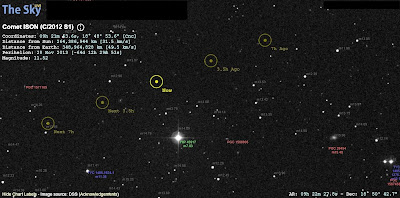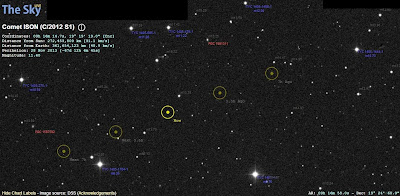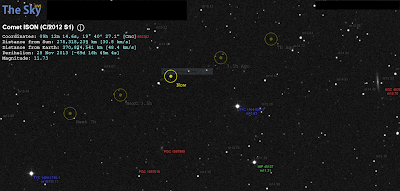So should I be scared?
When can I see Ison?
Comets are not like shooting stars, they don't streak across the sky before fizzling out, so you don't need to worry about blinking, Ison will be visible for weeks not seconds! Below is a quick reference guide, check out our "how to see Ison" for full details on how, when and where to view Ison.
September: During September will need a large amateur telescope to view Ison.
October: During October you should be able to see Ison with a decent pair of binoculars, or basic telescope.
November: Ison will be visible to the naked eye towards the end of November with the 28th being predicted to be the most spectacular due to it being at its closest point to the sun.
December: Come December we enter the unknown, due to the gravitational force of the sun Ison may well be torn apart. If Ison survives then during the start of December she will have positioned herself to close to the sun for easy viewing but with a bit of luck, may still be visible just before sun rise. By the end of the month Ison will have completed the trip around the sun and will be heading back just in time for new years eve when she will be right above us, over the north pole with a newly energized and hopefully even more dramatic tail.
January: Come January and some people may be suffering from comet fatigue, but Ison has saved the best for last! Around the 15th of January the earth will pass through Ison's tail made of fine dust and ice. This will produce spectacular meteor showers, but it is the finer dust that does not burn up which will produce the main show. As this dust enters our atmosphere it will cause noctilucent clouds, one of the rarest and most beautiful clouds to form. But her crowning glory, her swan song, will be the colours that are produced by the suspended dust particles in the upper atmosphere, reds, oranges and purple will light up our sky during the early evening like a psychedelic dream sequence!
February: As Ison heads back out away from us we expect Ison will only be visible with binoculars again.
March: Just like September she will only be visible with a amateur telescope, but don't despair as one comet leaves, another appears by the name of PanStarrs! (more info to follow)
Where can I see Ison?
Ison will be visible from all over the globe, but the northern hemisphere will get the best, and longest view. We recommend finding a dark place to view from, away from the city and the light pollution. Hills in the countryside are always a good place for astronomy, above the low level air pollution. It is worth doing a bit of reconnaissance or "reccy" to find a good spot.
The position in sky will change, it is moving object after all! You can check out where to look in our "How to View Ison" page which will be regularly updated as we track Ison across the heavens.
Why is it called Ison?
Ison is named after the International Scientific Optical Network, the organisation where it was discovered. Normally a comet would be named after the astronomers who discovered it, but on this occasion the media nicknamed it Ison and the name has stuck, which is unfortunate for Vitali Nevski and Artyom Novichonok who first discovered it! Technically Ison should be called "Nevski-Novichonok comet"
Ison is not really the name of the comet at all, just a easy to remember nickname. You may know that animals have two names a common name which we use everyday like "Tiger" and an official scientific or "Latin" name like "Panthera tigris". Comets are just the same, they have their scientific name known as its designation and a common name. Isons real name or designation is C/2012 S1 catchy or what!
C/2012 S1 might sound like a Starwars character but there is a reason for the name.
The letter C is given because it is non-periodic (not a regularly appearing comet like Halley's comet).
The number 2012 is simply the year it was discovered.
The letter S is given to to indicate when during the year it was discovered, a comet discovered between the 1st and 15th of January are given the letter A, from 16th to the 31st they are given B and so on. Ison was discovered on the 21 of September so got the letter S.
The Number 1 is shows it was the first comet to be discovered in "S" period (16th to 30th of September)
























